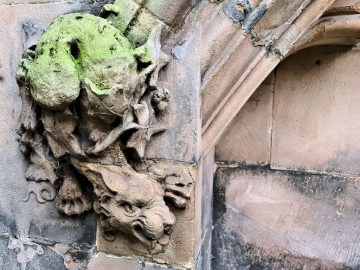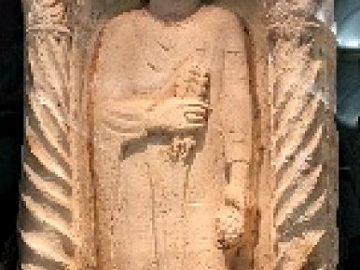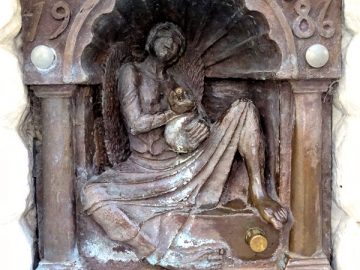Sheffield, in north-eastern England, has been known for steel production since the end of the Middle Ages, being particularly associated with production of high-quality cutlery. One of its most famous denizens was Thomas Boulsover and he was a central figure in the history of Sheffield in the 1700s, accidentally inventing Sheffield Plate in 1743 (a method of coating copper with silver). As Wikipedia states ‘While trying to repair the handle of a customer’s decorative knife, he heated it too much and the silver started to melt. When he examined the damaged handle, he noticed that the silver and copper had fused together very strongly‘. So, it’s no surprise that there is a sculpture of him in Sheffield City Centre, just uphill from the Crucible Theatre. Being a beautiful piece of art, and having links to industrial history, I obviously decided when I visited that it would make an excellent addition to my collection of historical 3D objects.
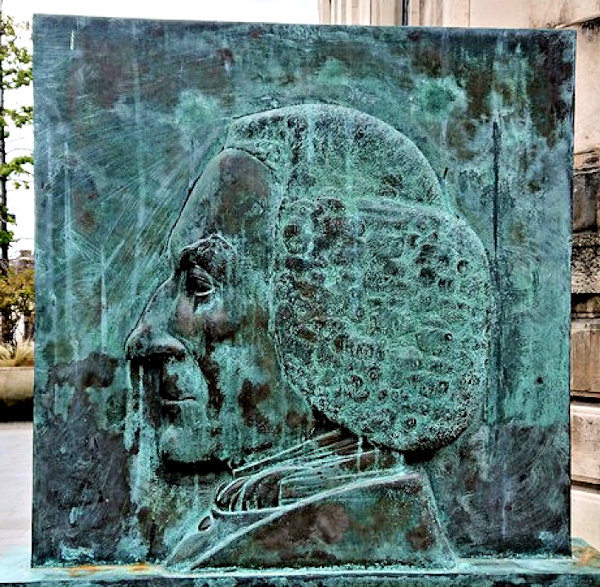
Quick summary of this 3D creation
Overview: A basic scan of a sculpture representing Thomas Boulsover, the inventor of Sheffield Plate, in Sheffield city centre.
Location: Sheffield city centre, Sheffield, England, United Kingdom [map].
Date/era: Unknown, probably 20th Century.
Software used: Sony 3DCreator Android app, Meshmixer.
Intended use: 3D printing, either in resin or fused filament, the latter being possible without any support material.
The scan was done using the Sony 3D Creator app on an Xperia XZ1 Compact smartphone. It didn’t pick up all of the fine details but it did a good job of creating a usable 3D representation. Given that 3DCreator is a free Android app, I obviously don’t expect amazingly detailed 3D scans from it, but it often pleasantly surprises me with just how good its scans can be. And for quick and spontaneous 3D scanning it’s hard to beat as you don’t have to upload images to a photogrammetry server and wait to see what emerges. If you don’t get a good scan you can see that straight away and try again.
The scan was then post-processed using Meshmixer to remove extraneous areas and to remesh to a sensible file size, for speed of use in the Sketchfab viewer, as well as to allow speedier downloads. The solidify tool was used for that, with the sharp edge preserving setting allowing a sensible file size with minimal loss of the limited detail contained in the original scan. Meshmixer has a wide range of available tools that are very useful for processing 3D scans, including 3D sculpting brushes that are as good as those in many commercial sculpting packages. And, while being provided by AutoDesk, the makers of widely used professional software such as AutoCAD, it’s also free to download and use. You can see the finished model on Sketchfab below (click the play button to load the model and view it in 3D).
The 3D printed version on the left in the photo below was printed in PLA, without support material, using an XYZPrinting DaVinci Jr printer. Using fine settings on the printer helped improve quality significantly, as it was only 40mm across. It was then primed, sanded and painted using Pebeo gold-effect acrylics, and finished with a protective coat of their varnish that also reduced the shininess of the gold paint. The version on the right was made by forming a mould, from the PLA print, in Pebeo two-part silicon, from which a resin version was cast using their two-part craft casting resin. If you want to try 3D printing it yourself, click here to go to the MyMiniFactory page, or here for the Thingiverse page, to download it.
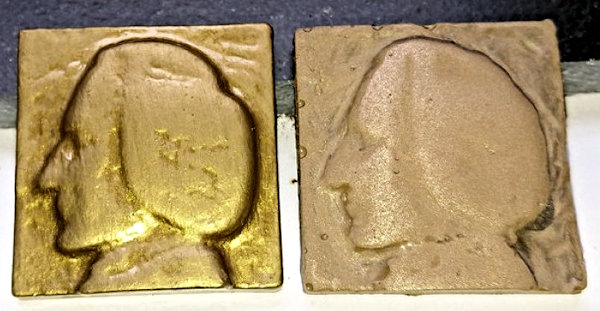
The resin had bronze powder added as a filler, which gave a more authentic look and a bit of extra weight. However, as the photo shows, even after a couple of days the resin wasn’t completely hardened, resulting in some surface loss when sanding to expose the metal powder. I’ve found that casting resin can take a lot longer to set hard enough to sand, compared to the instructions on the box. So I think it’s best to consider a day or so only enough hardening time for careful handling (and maybe before painting), and I tend to prefer a few days before sanding now (see, for example, my scan of the nearby Women of Steel right-hand head, cast with white sand filler). That’s especially true for thick models, and I think the colder temperatures here in the UK are probably a factor too. But, even with that problem, I think the finished bronze-effect cast came out quite well.
So finally, in case you’d like to use the methods in this project for your own work, let’s recap on what was involved:
- The Sony 3DCreator Android app was used to create a basic 3D scan on a smartphone, which provided a good representation, albeit with some loss of detail along sharp edges.
- On a PC Meshmixer was used to tidy the 3D scan, including cutting away unwanted material, smoothing poorly scanned areas, and sharpening edges.
- Meshmixer was also used to solidify/remesh the model, to achieve a much smaller file size.
- The finished 3D model was then test printed in PLA and found to print to an acceptable quality.
- Due to the limited amount of detail in the final model, resin printing wasn’t considered necessary, although it should work well, especially for small prints, and would have allowed use of thinner paints and so less loss of detail.
- A silicon mould was also made from the PLA print and used to make a version from casting resin. That worked well with bronze powder as a filler, giving a more metallic effect compared to painting.
- However, when casting in resin it’s best to leave it for a few days to completely harden, if surface sanding to expose metal-powder filler is desired.
Please note that this model is provided without any license for commercial use. It is intended simply as a historical model you can have the fun of printing yourself. And of course it is intended to be a motivation for you to visit Sheffield yourself and view this wonderful sculpture of Thomas Boulsover: click here to see the location in Google Maps.


